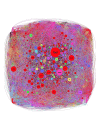The painful tweet: text, sentiment, and community structure analyses of tweets pertaining to pain
- PMID: 25843553
- PMCID: PMC4400316
- DOI: 10.2196/jmir.3769
The painful tweet: text, sentiment, and community structure analyses of tweets pertaining to pain
Abstract
Background: Despite the widespread popularity of social media, little is known about the extent or context of pain-related posts by users of those media.
Objective: The aim was to examine the type, context, and dissemination of pain-related tweets.
Methods: We used content analysis of pain-related tweets from 50 cities to unobtrusively explore the meanings and patterns of communications about pain. Content was examined by location and time of day, as well as within the context of online social networks.
Results: The most common terms published in conjunction with the term "pain" included feel (n=1504), don't (n=702), and love (n=649). The proportion of tweets with positive sentiment ranged from 13% in Manila to 56% in Los Angeles, CA, with a median of 29% across cities. Temporally, the proportion of tweets with positive sentiment ranged from 24% at 1600 to 38% at 2400, with a median of 32%. The Twitter-based social networks pertaining to pain exhibited greater sparsity and lower connectedness than did those social networks pertaining to common terms such as apple, Manchester United, and Obama. The number of word clusters in proportion to node count was greater for emotion terms such as tired (0.45), happy (0.43), and sad (0.4) when compared with objective terms such as apple (0.26), Manchester United (0.14), and Obama (0.25).
Conclusions: Taken together, our results suggest that pain-related tweets carry special characteristics reflecting unique content and their communication among tweeters. Further work will explore how geopolitical events and seasonal changes affect tweeters' perceptions of pain and how such perceptions may affect therapies for pain.
Keywords: Twitter messaging; emotions; social networks; text mining.
Conflict of interest statement
Conflicts of Interest: None declared.
Figures







Similar articles
-
Identifying Sentiment of Hookah-Related Posts on Twitter.JMIR Public Health Surveill. 2017 Oct 18;3(4):e74. doi: 10.2196/publichealth.8133. JMIR Public Health Surveill. 2017. PMID: 29046267 Free PMC article.
-
Applying Multiple Data Collection Tools to Quantify Human Papillomavirus Vaccine Communication on Twitter.J Med Internet Res. 2016 Dec 5;18(12):e318. doi: 10.2196/jmir.6670. J Med Internet Res. 2016. PMID: 27919863 Free PMC article.
-
Using Twitter to Examine Web-Based Patient Experience Sentiments in the United States: Longitudinal Study.J Med Internet Res. 2018 Oct 12;20(10):e10043. doi: 10.2196/10043. J Med Internet Res. 2018. PMID: 30314959 Free PMC article.
-
Current landscape of social media use pertaining to glioblastoma by various stakeholders.Neurooncol Adv. 2023 May 24;5(1):vdad039. doi: 10.1093/noajnl/vdad039. eCollection 2023 Jan-Dec. Neurooncol Adv. 2023. PMID: 37250621 Free PMC article. Review.
-
Sentiment Analysis of Health Care Tweets: Review of the Methods Used.JMIR Public Health Surveill. 2018 Apr 23;4(2):e43. doi: 10.2196/publichealth.5789. JMIR Public Health Surveill. 2018. PMID: 29685871 Free PMC article. Review.
Cited by
-
A systematic review of natural language processing and text mining of symptoms from electronic patient-authored text data.Int J Med Inform. 2019 May;125:37-46. doi: 10.1016/j.ijmedinf.2019.02.008. Epub 2019 Feb 20. Int J Med Inform. 2019. PMID: 30914179 Free PMC article.
-
Investigating Subjective Experience and the Influence of Weather Among Individuals With Fibromyalgia: A Content Analysis of Twitter.JMIR Public Health Surveill. 2017 Jan 19;3(1):e4. doi: 10.2196/publichealth.6344. JMIR Public Health Surveill. 2017. PMID: 28104577 Free PMC article.
-
Using Social Media to Characterize Public Sentiment Toward Medical Interventions Commonly Used for Cancer Screening: An Observational Study.J Med Internet Res. 2017 Jun 7;19(6):e200. doi: 10.2196/jmir.7485. J Med Internet Res. 2017. PMID: 28592395 Free PMC article.
-
Assessing Pain Research: A Narrative Review of Emerging Pain Methods, Their Technosocial Implications, and Opportunities for Multidisciplinary Approaches.Front Pain Res (Lausanne). 2022 Jun 2;3:896276. doi: 10.3389/fpain.2022.896276. eCollection 2022. Front Pain Res (Lausanne). 2022. PMID: 35721658 Free PMC article. Review.
-
Tweeting back: predicting new cases of back pain with mass social media data.J Am Med Inform Assoc. 2016 May;23(3):644-8. doi: 10.1093/jamia/ocv168. Epub 2015 Dec 11. J Am Med Inform Assoc. 2016. PMID: 26661720 Free PMC article.
References
-
- https://business.twitter.com/en/basics/what-is-twitter/ 2014. [2014-05-22]. What is Twitter? https://business.twitter.com/twitter-101.
-
- Barber MJ. Modularity and community detection in bipartite networks. Phys Rev E Stat Nonlin Soft Matter Phys. 2007 Dec;76(6 Pt 2):066102. - PubMed
-
- Blondel VD, Guillaume J-L, Lambiotte R, Lefebvre E. Fast unfolding of communities in large networks. J Stat Mech. 2008 Oct 09;2008(10):P10008. doi: 10.1088/1742-5468/2008/10/P10008. - DOI
-
- Chew C, Eysenbach G. Pandemics in the age of Twitter: content analysis of Tweets during the 2009 H1N1 outbreak. PLoS One. 2010;5(11):e14118. doi: 10.1371/journal.pone.0014118. http://dx.plos.org/10.1371/journal.pone.0014118 - DOI - DOI - PMC - PubMed
-
- Lancichinetti A, Fortunato S. Community detection algorithms: a comparative analysis. Phys Rev E Stat Nonlin Soft Matter Phys. 2009 Nov;80(5 Pt 2):056117. - PubMed
Publication types
MeSH terms
Grants and funding
LinkOut - more resources
Full Text Sources
Other Literature Sources
Medical

